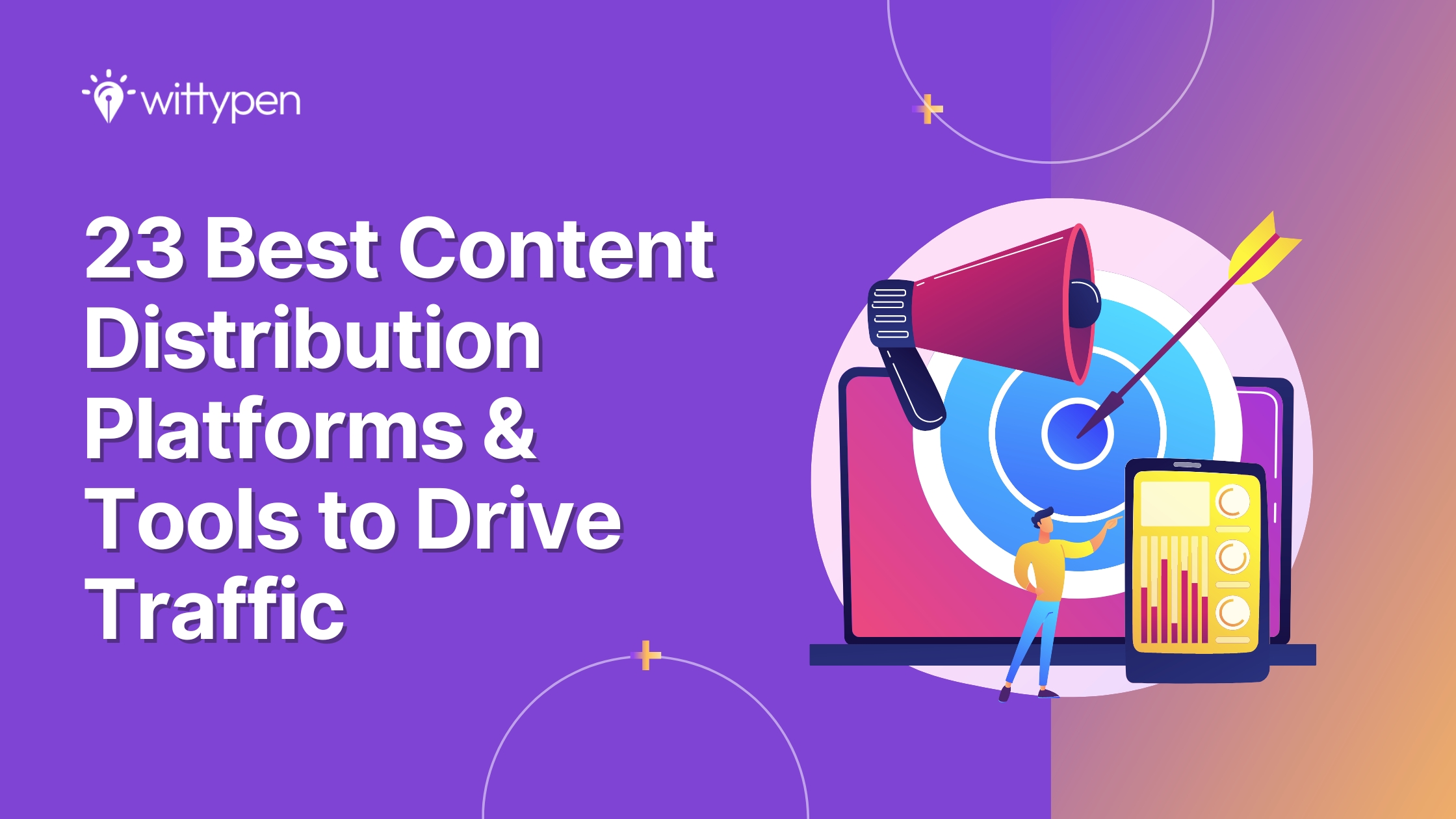Navigating the world of content marketing ROI can be complicated for many marketers. They might often find themselves questioning the effectiveness of their content marketing efforts and wonder if they are truly paying dividends.
According to the Content Marketing Institute, about 20% of B2B marketers can still not assess the success of their content marketing efforts, and about 60% lack a documented content strategy. This knowledge gap is lamentable. Marketers should be able to effectively assess the success of their content marketing strategy.
This post delves into the world of Content Marketing ROI, offering insights into what constitutes it, how to quantify it, and the critical content metrics to contemplate.
Content Marketing ROI Basics
Let’s start with understanding the basics of Content Marketing ROI to gain a comprehensive understanding.
What is Content Marketing ROI?
In any business, return on investment or ROI usually measures how successful a particular effort has been since revenue has a direct bearing on it.
Content Marketing ROI is a percentage that indicates how much revenue the company has obtained from content marketing when compared to how much they had spent on creating and distributing the content. If the organization produces and promotes great quality content regularly, the ROI on content marketing will indeed be good.
Content marketing ROI aims at three things:
- To boost traffic to the website.
- To convert such traffic into good-quality leads.
- To convert and close the leads into sales.
Conversions are integral to the content marketing ROI model and are a metric for determining the success of any content marketing strategy. The company can then quantify the conversions in terms of sales potential to predict the content marketing ROI.
Let’s take a detailed look at how one can measure content marketing ROI.
Why Should One Calculate the ROI of Content Marketing?
Calculating ROI on content marketing allows a marketer to make smarter investments, fine-tune strategy for better results, and showcase their value to stakeholders. They can allocate company resources wisely by identifying where the content marketing efforts are paying off the most.
When dealing with stakeholders, showing marketing’s impact on the revenue ensures continued investment in content marketing.
If you are a marketing agency, linking content to revenue is the best way to win over potential clients, especially in the B2B sector, where the focus is on tangible business outcomes rather than just website traffic metrics.
How to Calculate Content Marketing ROI?
The content marketing formula to calculate the ROI is simple. The idea is to calculate the cost of content against the revenue earned. Here’s how it is derived.
STEP 1 – Determine how much was spent to create your content
Whether the content is produced in-house or sourced externally, there is always a cost incurred. Creating it in-house means a content specialist was employed to do the job against a monthly salary. The same is the case when a freelance content writer is hired.
The cost of producing content also includes expenditure on creating content assets like video, graphics, audio, and presentation, whether done in-house or not.
STEP 2 – Estimate the cost of distributing the content
Distributing the content to communicate them to the right channels will also involve in-house and external costs. This will include paid promotions like social advertising and PPC advertising and also promotion through other media channels. Add to this the cost of any special tools or software necessary for content creation or distribution.
Adding up all the expenses in Steps 1 and 2 will give the actual cost of producing the content.
STEP 3 – Calculate the amount of revenue the company got in return
There is a direct correlation between content and revenue. When someone reads the content, clicks the call-to-action button, and avails of the products or services, the content generates revenue. Well-created and suitably distributed content creates leads and often results in sales if everything goes well. Some less obvious content metrics will be covered in the later part of this blog.
Add up all the sales that are a result of the content to arrive at the figure of the total revenue.
STEP 4 – Calculating content marketing ROI
A simple formula works here.
Content Marketing ROI (%) = [(Return-Investment)/Investment] x 100
Return divided by Investment and expressed as a percentage will give the ROI.
If expenditure on a piece of content outsourced from a content marketing campaign is INR 10,000 and the sales resulting from that amounts to INR 30,000, then the return on investment or ROI is INR 20,000 or a gain of 200%!
Content Marketing ROI (%) = [(30,000-10,000)/10,000] x 100 = 200%
Revenue should not be considered the only direct indicator of how successful the content marketing strategy is; for some brands, the ROI comes from some indirect factors like brand awareness, customer loyalty, brand advocacy, etc.
So, what is a good content marketing ROI measurement approach, and which metrics are responsible for it?
Metrics Generally Used for Measuring Content Marketing Success
One should consider these important content metrics for measuring the success of content marketing strategies. However, it may not be possible for everyone to track all of them. Choose only a few based on pre-determined goals!
1. Web Traffic
Think about it. There cannot be any revenue without traffic.
The content marketing efforts can be successful only if there’s traffic.
Use Google Analytics to understand how much traffic has been directed to the website because of a content piece. In the main menu, follow the options Behaviour > Site Content > Landing Pages. This report shows the pages that are visited by the website visitors first.
2. Lead Quality
Good content draws the target audience to the website naturally. It’s these visitors who generate leads, which in turn makes content marketing absolutely important for lead generation.
The posts are drawing qualified leads if:
- People read the blog posts and consider availing of the services offered.
b. Visitors read related resources.
c. When visitors get in touch with the sales team with queries.
Such actions show that the visitors are interested in what the website has to say and the content is generating quality leads.
Set goals in Google Analytics to see if the site visitors are also checking out important pages such as your pricing page.
If the traffic on the website is good, but the bounce rate is high, and conversions are low, it shows that the leads are of low quality, and the visitors aren’t really interested in what the website has to offer (considering content and offering is relevant).
3. Sales
If anyone wants their leads to convert to sales, the key is to provide valuable content to the visitor the instant they come looking for it. If the qualified leads are nurtured with quality content, at least some of them will be prompted to buy something.
Enable e-commerce in Google Analytics if you want to get the exact numbers of conversions in the form of sales. Navigate to Behaviour > Site Content > All Pages and the Page Value column will show the average value for one page a user visited before landing on the targeted page or availing a product or service.
This figure will give a general idea of the pages on the website that contribute significantly more to revenue than the others.
4. Customer Feedback
Customer reviews have a direct bearing on content marketing success.
Yes, you got that right!
If a product or service is reviewed positively, it means the offering is a high revenue earner, and the target audience has accepted it well.
The content provided for the offerings should be in tune with what a buyer will actually get. Refrain from making tall claims in content and promise only what’s fair.
5. Time Spent Onsite
Merely getting the target audience to the webpage is not good enough if they are not hooked to stay there.
This means the pages should ideally have a low bounce rate, and people should come back the next time they need something. It is only then that the content is working and helping in generating leads.
If people are reading the content till the end or are subscribing to your weekly newsletter, it means they like the posts and look forward to reading about you the next time.
6. SEO Rank
The SEO success of the pages depends on how they perform in the search results during a search. People usually do not go lower down on the SERPs and mostly click the results that they see on top.
The pages are well optimised for search engines if one’s getting good inbound links, have high domain authority, and the content ranks well for the target keywords, and the text appears in search boxes for relevant items.
7. Social Media ROI
Any guesses for the online platforms one will find most of your target audience frequenting? Social media sites are where they virtually hang out!
If the business is prominent on Facebook, Instagram, Snapchat, and Twitter, it means that they have good offsite engagement. This is important for assessing content marketing ROI. If the fans or followers like the posts, they will want to link them or share them with others on social media.
Keeping track of social media engagement helps. Recommendations and shares from friends often have an impact on purchase decisions on social media.
Google Analytics can help the marketer get the stats on how much traffic is coming in through individual social media sites. To check this, they can follow the path Acquisition > Social > Network Referrals.
To know the revenue they are earning through traffic on social media, go to Acquisition > Social > Overview.
8. Exposure and Authority
When a brand manages to establish its authority online over any content, it means people will want to be linked to it and share what they post. This improves the visibility and reach and contributes to generating leads and closing sales.
While this authority cannot be quantified per se, searching for a topic keyword will tell the marketer if their site appears in the top results.
Offline authority and exposure can be judged by the coverage a company gets from media channels, including TV and radio, and if they are being invited to take part in industry events and expert discussions.
Being an essential parameter of defining content marketing success, these factors also ascertain how well the brand is recognized. High exposure and authority aid in directing interested people to the website.
What Kind of Content Marketing ROI to Expect?
Content marketing ROI can be influenced by several factors, which include:
- Quality of the content
- Where was the content distributed?
- SEO rankings
- Conversion rate
- Old marketing campaigns
- Marketing channels used
- Original and repurposed content
- Competition
- Content relevance
And the list goes on. What is essential to understand is that no campaign will yield the same results. Content marketing ROI statistics will vary based on a lot of different factors.
Hence, when setting expectations, always keep in mind that the key to achieving a favourable ROI in content marketing is adaptability. It’s essential to adjust the campaign and goals over time.
Best Practices for Analysing Content Marketing ROI
Let’s delve into the best practices for analysing content marketing ROI to optimize strategies and make the most out of it.
- Invest in high-quality content that resonates with your audience. Engaging and informative content leads to better returns.
- Continuously analyze your audience’s behavior and tailor your content to address their needs effectively.
- Look for the distribution channels that are working for you and leverage those.
- Focus on optimizing your content for conversions. Include clear and compelling calls to action and see which ones work better in guiding visitors toward desired actions.
- Maximize ROI by repurposing existing content into different formats, such as videos, infographics, or podcasts, to reach a wider audience.
Content Marketing Campaigns That Stood Out in 2022
Let’s dissect some of the most effective content marketing campaigns of 2022 that set the bar for success in the industry.
Spotify Wrapped
Spotify Wrapped, one of the most memorable content marketing campaigns by Spotify, employed a multi-channel approach to engage its users:

- In-app experience: They delivered the Wrapped experience directly to users. The users were greeted with personalized insights whenever they opened the Spotify app.
- Email marketing: Users were notified by email about the availability of their Wrapped summaries.
- Collabs: Spotify collaborated with influencers and celebrities to increase the campaign’s reach.
- Sharing on social media: Users were encouraged to share their Wrapped playlists on Facebook, Instagram, and Twitter, creating curiosity for people who were not using Spotify.
Apple’s ‘Shot On an iPhone’
This campaign is another remarkable content marketing initiative that focuses on the photography and videography capabilities of iPhones. This was a global campaign where users submitted their own visually captivating photos and videos and were then featured in Apple’s marketing materials.

This was a campaign that was put to success using the following channels:
- TV ads: Apple used the most beautiful visuals in its TV commercials to reach a broad audience.
- Print ads: ‘Shot On an iPhone’ photos were featured in magazines, newspapers, and on billboards.
- Social media: Instagram, Twitter, and Facebook were used to share user-generated content and paid social media advertising to expand the campaign’s reach.
Unlock the Power of Content Marketing
As marketers, understanding how the content is received, who the audience is, and how they engage with the content is crucial. These metrics not only provide valuable insights but also guide in refining our content strategy to ultimately enhance our overall content marketing ROI.
At Wittypen, you can find expert content writers who work to further the content marketing strategy. They are skilled at understanding business requirements and aligning the content to unlock the full potential of your content marketing efforts.
FAQs
- How can I measure the ROI of my content marketing efforts effectively?
You can measure the ROI of content marketing by setting clear goals, tracking relevant metrics, assigning monetary values to conversions, calculating costs, and using the ROI formula. Also, you should regularly review performance and adjust strategies to keep your content marketing strategy up-to-date.
- What are the key metrics to track when measuring content marketing ROI?
The key metrics are:
- Web traffic
- Lead quality
- Sales
- Customer feedback
- Time spent on-site
- SEO rank
- Social media ROI
- Exposure and Authority
- What tools and techniques can I use to measure content marketing ROI?
Tools that marketers widely use include Hubspot, Google Analytics, Databox, CallRail, Improvely, and Pretty Links, alongside other CRM systems and social media conversion tracking software. Calculating the ROI formula is one of the chief methods against all.
- What are the common challenges in measuring content marketing ROI, and how can they be overcome?
Here’s a list of some common challenges and how to overcome them:
- Have specific, measurable goals for each content piece. Without this, it is hard to track the impact of the campaign.
- Compare ROI with industry benchmarks for context.
- Use advanced analytics tools to track performance accurately.
- Can you provide some case studies showcasing successful measurement of content marketing ROI?
Spotify Wrapped and Apple’s ‘Shot on an iPhone’ are the best examples from recent years. Other campaigns include Canva’s Design Contest, HubSpot’s Academy, and H&M Magazine.









